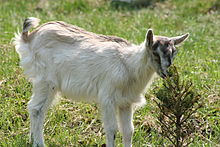염소
Appearance
Korean
[edit]Pronunciation
[edit]- (SK Standard/Seoul) IPA(key): [jʌ̹msʰo̞]
- Phonetic hangul: [염소]
| Romanizations | |
|---|---|
| Revised Romanization? | yeomso |
| Revised Romanization (translit.)? | yeomso |
| McCune–Reischauer? | yŏmso |
| Yale Romanization? | yemso |
Etymology 1
[edit]
First attested in the Beonyeok nogeoldae (飜譯老乞大 / 번역노걸대), 1517, as Middle Korean 염〮쇼〮 (Yale: yémsyó), from 염〮 (Yale: yém, “goat”) + 쇼〮 (Yale: syó, “cow”); the former element is no longer used outside this compound.
Noun
[edit]Usage notes
[edit]- In Chinese and Japanese, the word for "goat" is 山羊 (shānyáng)/山羊 (yagi). But in Korean, the equivalent 산양(山羊) (sanyang) usually refers to the unrelated long-tailed goral. The "goat" sense is attested but rare.
Derived terms
[edit]- 들염소 (deuryeomso, “ibex”)
- 염소띠 (yeomsotti)
- 염소젖 (yeomsojeot)
- 염소마마 (yeomsomama)
- 염소자리 (yeomsojari)
- 염소웃음 (yeomsouseum)
- 염소날 (yeomsonal)
- 하늘염소 (haneuryeomso)
- 솜털염소 (somteoryeomso)
Etymology 2
[edit]| Chemical element | |
|---|---|
| Cl | |
| Previous: 황(黃) (hwang) (S) | |
| Next: 아르곤 (areugon) (Ar) | |
Sino-Korean word from 鹽素, from an orthographic borrowing from Japanese 鹽素 (enso).
Noun
[edit]Categories:
- Korean terms with IPA pronunciation
- Korean terms inherited from Middle Korean
- Korean terms derived from Middle Korean
- Native Korean words
- Korean lemmas
- Korean nouns
- ko:Chemical elements
- Sino-Korean words
- Korean terms borrowed from Japanese
- Korean orthographic borrowings from Japanese
- Korean terms derived from Japanese
- ko:Caprines
